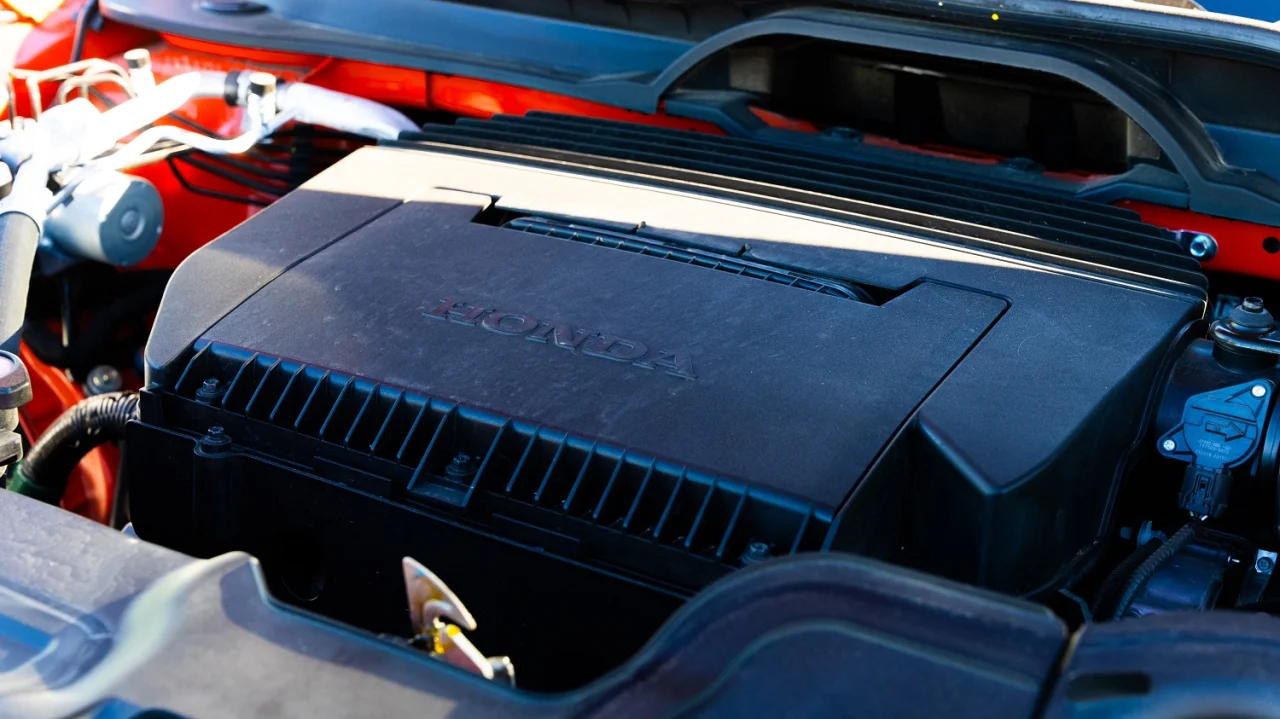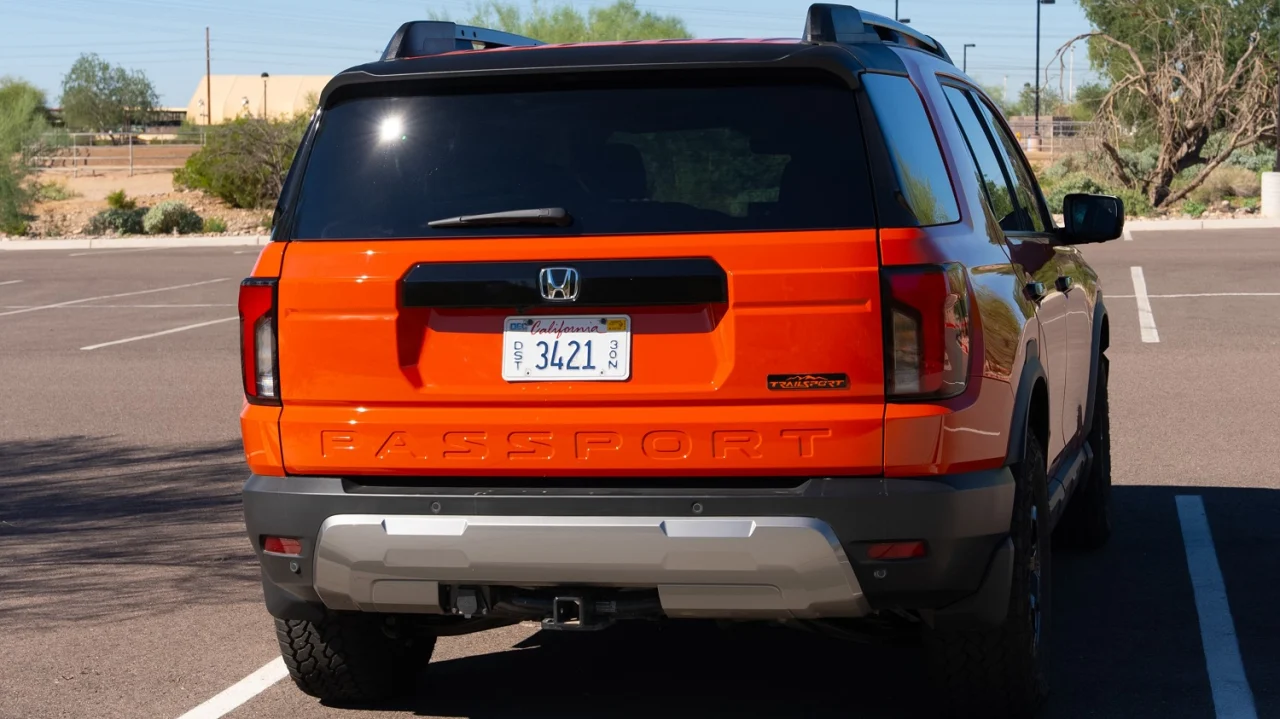It’s no mystery that SUVs are popular these days—just count how many you pass on the way out of your neighborhood. But over the past several years, a shift has taken place in that segment of the market, one influenced by American buyers’ love of adventure and off-roading. Not only has this benefited dedicated body-on-frame vehicles, but it has also left its mark on vehicles that were once strictly soft-roaders designed for gravel trails and the occasional patch of slippery terrain. That’s why you see Hyundai SUVs that look like Land Rovers and more “mall crawlers” with low-level off-road tech. And it explains the existence of the 2026 Honda Passport TrailSport Elite we recently tested.
A LONG PATH
You may remember the first two generations of the Honda Passport from the 1990s and early 2000s, when it was essentially a badge-engineered Isuzu Rodeo. After a long hiatus, Honda introduced a second-generation Passport for the 2019 model year. Three years later, Honda went into uncharted territory with the first-ever Passport TrailSport, which was “created for active buyers who thrive on adventure.” It came equipped with torque-vectoring i-VTM4 all-wheel drive and 8.1 inches of ground clearance but, otherwise, the TrailSport treatment was largely cosmetic. Fortunately, it was just the start of the path Honda was heading down. The automaker promised that “the off-road capability of the Passport TrailSport will increase further with possible future upgrades such as more aggressive tires and off-road tuned suspension.”
PASSPORT RENEWAL
That brings us to the 2026 Passport, which is all-new from the tires up to the stronger roof rails. It’s based on a significantly stiffer new chassis with a 2.7-inch longer wheelbase, and 1.3-inch wider (front) and 1.5-inch wider (rear) tracks. Everything around it is new as well, including the front suspension, multilink rear suspension, and larger disc brakes. The second-generation torque-vectoring i-VTM4 system’s rear drive unit has a 40 percent higher torque capacity and responds 30 percent faster. The boxy body covers a quieter, roomier cabin equipped with standard fatigue-reducing Body Stabilizing Seats in the first row, a 10.2-inch digital instrument cluster, 12.3-inch infotainment touchscreen with wireless Android Auto and Apple CarPlay, and wireless charging pad. Better camera and radar coverage, and new features (such as Traffic Jam Assist and a Traffic Sign Recognition System), join the Honda Sensing suite of safety and driver assistance technologies.

The all-new DOHC 3.5-liter V6 with higher-pressure direct fuel injection and Variable Cylinder Management generates 285 horsepower and 262 lb.-ft. of torque, making it the most powerful V6 Honda has ever offered in the U.S. Honda pairs that with the Passport’s first-ever 10-speed automatic.
There are three basic tiers to the Passport’s trim levels: RTL, TrailSport, and TrailSport Elite, but there are variations of each of those, including the RTL Towing and Blackout versions of all three. Prices start at $44,750*. Our TrailSport Elite had an MSRP of $52,450, which included the $455 TrailSport-exclusive Sunset Orange paint; total as-tested price was $54,355.

MORE THAN BADGES AND TRIM
Given that the 2026 Passport is based on unibody architecture and doesn’t have low-range four-wheel drive or a locking differential, it’s easy to assume that it’s a poser with its blockish bodywork, chunky rocker panel trim, and beefy tires. True, the Passport is no Jeep Wrangler, but it’s not supposed to be. Plus, there’s function to its form—and strategy behind it. Much of that strategy was focused on protecting the TrailSport from Mother Nature. Steel skid plates guard the oil pan, transmission, and gas tank. To keep the TrailSport from scraping its chin, Honda shortened the front overhang and increased the approach angle to 23 degrees. The breakover and departure angles are down slightly from the 2025 model’s figures (to 16.7 and 23.1 degrees, respectively), but engineers tucked the exhaust tips behind the rear bumper so they don’t get crunched on rocks. Honda even went as far as equipping the attractive two-tone wheels with sunken valve stems to prevent them from getting mangled and leaking air.
Protection is important, but so is progress. The TrailSport’s all-terrain rubber (275/60 General Grabbers) was a no-brainer. Reduced stabilizer bar rates boost the suspension’s articulation while the tuned dampers with lower compression and higher rebound damping strike a balance between pavement and trail performance. All Passports have i-VTM4 all-wheel drive, but only the TrailSport models have integrated “trail torque logic” for the rear end. In certain conditions, such as when one tire has grip and the other is in the air, the feature sends up to 75 percent of available power to the tire with the most traction and the remainder to the other tire so that full power can be applied immediately once both of them hook up with solid ground. If the going gets a little too rough, there are recovery points at the front—including one integrated into the engine/transmission skid plate—and rear.
INNER PEACE
The TrailSport’s cabin shows a similar level of focus. Trail, Sand, and Tow modes bring the total number of available drive modes to seven. Keeping an eye on the TrailSport Elite’s extremities is easier thanks to its standard TrailWatch camera system, which provides wide shots of the front and rear ends, a birds-eye perspective, and side views. Off-road gauges in the instrument cluster show the TrailSport’s elevation, and pitch and roll angles.

Luckily, that dedication didn’t come at the expense of comfort or convenience. The TrailSport Elite offered plenty to like in both rows of its Brown perforated leather seats. The design of the door panel trim looked straight out of a high-end furniture store. All the major controls were laid out well and easy to reach. The metallic knobs for the automatic climate control system looked as nice as they felt.
Accommodations in the second row were surprisingly generous. Headroom and legroom were plentiful. It was almost impossible not to dial in the perfect temperature because there were manual side sunshades, a dedicated climate zone, and heated outboard seats. Lowering the back row increased the TrailSport’s cargo capacity from 44 to 83.2 cubic feet—more than enough to carry a 51 x 17.5 x 29-inch chest of drawers to a Goodwill donation center.

LAID BACK
On the road, the TrailSport’s lack of body-on-frame construction and solid axles was its greatest advantage. Even with all-terrain tires and an off-road suspension, the TrailSport had a comfortable, floaty ride. The steering was similarly relaxed, going from feeling like it was in molasses to firm and heavy the more I turned the wheel. It was so easy to modulate the brakes that it was hard to discern the bite point in the pedal’s swing of travel.
The Passport’s V6 is based on a new block, topped with new cylinder heads, and filled with a new crankshaft and pistons. Despite those changes and its milestone output levels, the engine reminded me of the old V6 in the 2025 Ridgeline TrailSport we reviewed earlier this year. It never felt underpowered, but it didn’t feel all that enthusiastic, either—it was a bit sleepy. Fortunately, the 10-speed auto was relatively quick about jumping down a gear or two to wake it up, especially in its sport setting. Another plus was that the new engine lived up to its fuel economy ratings. Officially, it’s capable of returning 18 mpg in the city, 23 on the highway, and 20 combined—my colleague Luke Lamendola and I averaged 22.8 mpg over the course of 434.9 miles.
To learn even more about the 2026 Honda Passport TrailSport, check out Luke’s full video review below.
*Prices exclude $1,495 destination charge
Click above and watch our full video review on YouTube!
This video is sponsored by Legendary Car Protection. Car ownership today comes with high expectations and high risks. A well-designed Vehicle Service Contract not only protects your finances, but also ensures your vehicle receives the care it deserves – no matter how iconic, rare, or routine it may be. To explore tailored protection options for your specific vehicle, visit LegendaryCarProtection.com.

